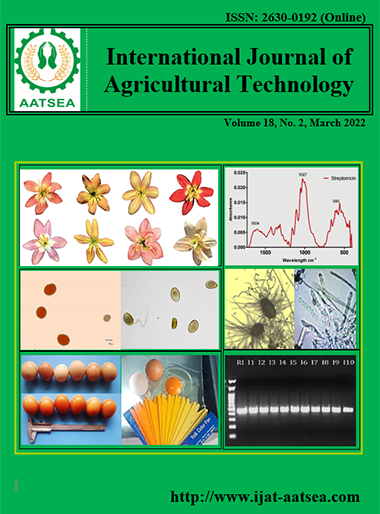Egg production, quality, and hatchability rates of Philippine ducks (Anas luzonica) in response to low-cost cassava-based rations
Main Article Content
Abstract
It is the firstly reported the effects of cassava-based ingredients at the inclusion of 30 to 40% (cassava meal and cassava leaf meal) on the overall ducks' egg performance, quality, and hatchability. The different treatments significantly impacted the ducks' egg production and quality parameters except for the hatchability rates (df=4, 8; F=0.42; P=>0.05). Treatment 4 (pure commercial feeds) produced the highest number of eggs per year (df=4, 8; F=29.36; P=000) at 277 and followed by treatment 5 (farmer-based formulation and commercial feeds [1:1 ratio] at 200. In terms of the quality parameters, the ducks in treatments 1 (30% cassava-based ration), 2 (35% cassava-based ration), and 3 (40% cassava-based ration) produced medium eggs with 31.74%, 27.01%, and 28.52%, respectively. The ducks yielded extra-large eggs in treatment 4 at 37.68% and treatment 5 at 40.69%. Treatment 4 produced the heaviest weight per egg at 60.0 g (df=4, 8; F=8.13; P=<0.01) while Treatment 2 produced the heaviest shell at 11.0 g (df=4, 8; F=6.68; P=<0.05). The egg performance of ducks fed with cassava-based materials is not comparable to those fed with pure commercial feeds and a combination of farmer-based formulation with commercial feeds (1:1 ratio). Further study is recommended to increase the study duration to three months to attain the peak of egg production, especially for the cassava-based ration-fed ducks.
Article Details

This work is licensed under a Creative Commons Attribution-NonCommercial-NoDerivatives 4.0 International License.
References
Abro, Z., Kassie, M., Tanga, C., Beesigamukama, D. and Diiro, G. (2020). Socio-economic and environmental implications of replacing conventional poultry feed with insect-based feed in Kenya. Journal of Cleaner Production, 265:121871.
Debnath, J., Sarkar, D. and Das, T. K. (2020). Socio-economic status of duck farmers and duck rearing system in India: A review. Journal of Entomology and Zoology Studies, 8:1262-1266.
Gul, H., Chen, X. and Geng, Z. (2021). Comparative Yolk Proteomic Analysis of Fertilized Low and High Cholesterol Eggs during Embryonic Development. Animals, 11:744.
Gutierreza, A. C. (2019). An Analysis of Duck Egg Production in the Philippines: Factors Affecting the Decision of Duck Raisers on the Choice of Stock Replacement for Duck Egg Production. Journal of Asia Trade and Business, 6:21-37.
Jackson, J. and Chiwona-Karltun, L. (2018). Cassava production, processing and nutrition. Handbook of Vegetables and Vegetable Processing, 609-632.
Lambio, A. L. (2000). Status, problems and prospect of the duck industry in the Philippines. San Miguel Corporation Professorial Chair Lecture, College, Laguna (Philippines), June 30, 2000.
Latif, S. and Müller, J. (2015). Potential of cassava leaves in human nutrition: A review. Trends in Food Science & Technology, 44:147-158.
Lei, X. J., Park, J. H., Hosseindoust, A. and Kim, I. H. (2017). Effects of cassava (Manihot esculenta Crantz) root meal in diets containing corn dried distillers grains with solubles on production performance, egg quality, and excreta noxious gas emission in laying hens. Brazilian Journal of Poultry Science, 19:239-246.
Montagnac, J. A., Davis, C. R. and Tanumihardjo, S. A. (2009). Nutritional value of cassava for use as a staple food and recent advances for improvement. Comprehensive Reviews in Food Science and Food Safety, 8:181-194.
Morgan, N. K. and Choct, M. (2016). Cassava: Nutrient composition and nutritive value in poultry diets. Animal Nutrition, 2:253-261.
Ndubuisi, N. D. and Chidiebere, A. C. U. (2018). Cyanide in cassava a review. International Journal of Genomics and Data Mining. Retried from DOI:10.29011/2577-0616.000118.
Nova, T. D., Rizal, Y. and Sari, S. Y. (2021). The Effect Levels of Cassava Leaf and Palm Kernel Meal Fermented Used Bacillus amylolicofaciens in Laying Duck Feed. IOP Conference Series: Earth and Environmental Science, 757:012055.
Okereke, C. O., Ukachukwu, S. N. and Umesiobi, D. O. (2008). Assessment of egg production indices of layers following dietary inclusion of composite cassava (Manihot esculanta) meal. Journal of Applied Animal Research, 33:69-72.
Omeire, G. C., Iwe, M. O. and Uchechukwu, N. (2012). Effect of extrusion variables on the hydrogen cyanide and haemagglutinin content of extruded blends of cassava products and African yam bean. Food Science and Quality Management, 6:23-32.
Pawariya, V. and Jheeba, S. S. (2015). Economic Analysis of Poultry Enterprise in Jaipur District of Rajasthan State Of India. Exploratory Animal and Medical Research, 5:213-223.
Philippine Statistics Authority (2020). Psa.Gov.Ph. Retried from https://psa.gov.ph/livestock-poultry-iprs/duck/inventory
Sulaeman, A. (n.d.). The Effect of Different Levels of Fish-Cassava Silage Addition in Ration on Local Duck Egg Quality.
Sumiati, S., Darmawan, A. and Hermana, W. (2020). Performance and Egg Quality of Laying Ducks Fed Diets Containing Cassava (Manihot esculenta Crantz) Leaf Meal and Golden Snail (Pomacea canaliculata). Tropical Animal Science Journal, 43:227-232.


